Apple is reportedly revisiting and expanding its development of haptic “solid-state” buttons for upcoming devices, including iPhones, iPads, and Apple Watches. This move suggests a potential shift away from traditional mechanical buttons across its product lines, driven by perceived advantages.
Key Highlights:
- Expanded Haptic Button Development: The haptic button project, previously rumored for iPhones, is now said to encompass iPads and Apple Watches, indicating a broader strategic adoption by Apple.
- Benefits of Solid-State Buttons: These non-moving buttons offer significant advantages, such as eliminating mechanical wear (leading to zero wear over time) and allowing for diverse functionalities based on press intensity or duration (e.g., light press vs. firm press, short press vs. long press).
- Previous Shelved Plans: Haptic buttons were most recently rumored for the iPhone 16 Pro and Pro Max, but those plans were allegedly put on hold, making this renewed development noteworthy.
- Addressing Mistouch Challenges: The primary reason for previous delays in launching devices with haptic buttons is reportedly the challenge of resolving unintended touches. Apple is believed to be working on perfecting this aspect.
- Future Product Integration: While it’s unlikely haptic buttons will appear on Apple products this year, speculation suggests they could be refined and ready in time for future device generations, possibly even the iPhone 18 family.
This renewed and expanded focus on haptic technology underscores Apple’s commitment to innovating user interfaces and enhancing both the durability and versatility of its devices across its core product categories.
For more information, you can read the full article on GSMArena.com: Apple now rumored to be developing haptic buttons for iPhones, iPads and Apple Watches
📢 Disclaimer
This article is based on information from trusted tech news sources. Techwhatif.com summarizes and adapts these insights to make tech news more accessible to our readers. Full credit goes to the original authors and publications. If you're the content owner and have any concerns, please contact us directly for resolution.



